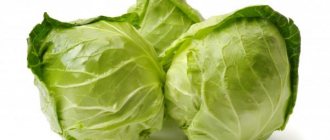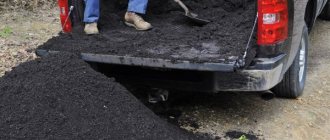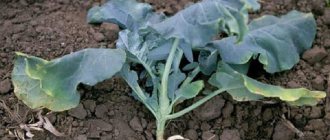The main causes of cracks in cabbage
There can be many reasons why cabbage bursts in the garden. This is largely due to improper care. It is recommended to familiarize yourself with preventive measures that will help prevent the appearance of cracks on cabbage heads.
Untimely watering
Irregular watering may well spoil the harvest in the garden. After a long drought, prolonged rains often occur. During them, the cabbage tries to absorb a large amount of moisture, since it may soon lose it again.
Cracked cabbage head
The leaves inside the head of cabbage begin to swell from a large amount of moisture, thereby damaging the outer shell. A similar situation can befall gardeners who grow crops in their dachas. They cannot water regularly, which is why the cabbage cracks.
Temperature changes
Ideally, cabbage should be grown in a temperature range from +18 to +22 degrees. You can’t always wait for such weather: in most cases, the temperature changes quite sharply, which is why the heads of cabbage can crack.
This happens for the following reason: in the heat the crop stops growing, and in the cold this process resumes. In this case, the inner part of the head of cabbage grows faster than the outer part, and therefore it can burst.
Note! The most unfavorable situation can be considered when watering is not carried out in extreme heat. After the cabbage receives moisture, it will begin to intensively absorb the element that it was deprived of, which is why the head of cabbage will burst.
Late collection
It is also worth harvesting on time. If there is no opportunity to cut the heads of cabbage and put them away for storage, then they continue to grow and, as a result, crack.
It is necessary to choose the time depending on the variety, since ripening periods vary.
Lots of moisture
The main reason why cabbage cracks is excess moisture. The need for watering increases with the growth of cabbage heads. During such periods, watering is required almost daily, using about 8 liters of water.
Cabbage bursts from excess moisture
During the growing season, much less moisture is needed, and therefore the frequency should be reduced to a minimum. If you continue with traditional watering, the cabbage will begin to crack.
The cause of excess moisture in the soil can be not only the gardener, but also rain. If rainy weather with daily precipitation occurs in the middle or end of the growing season, there is a high probability of obtaining a crop with cracks.
Why does cabbage crack?
The main reason that causes cabbage forks to crack is an imbalance in the water balance in the soil. This may be caused by:
- irregular watering;
- excessive watering;
- rainy summer;
- sudden changes in temperature;
- late harvest.
Cabbage is a moisture-loving crop; a constant flow of moisture is vital for it. A long break in watering, drying out of the soil and high (or low) temperatures lead to the growth of the entire plant stopping. If you abruptly resume watering, the roots begin to intensively feed the juicy young leaves inside the head of cabbage. They begin to grow at an accelerated pace, while the outer, already formed leaves consume moisture much more slowly. Under the pressure of quickly absorbing moisture from the leaf layers, the head becomes rough, then the tissues tear and the head bursts.
The same thing happens after a change in temperature: when the temperature drops to below 15 degrees or when the temperature rises to 30 degrees or more, the head of cabbage stops developing. And when weather conditions become comfortable again, a sharp jump in growth occurs. The outer and inner foliage develop unevenly, which inevitably leads to the appearance of cracks.
By the way! Most often, early varieties of cabbage crack. This is caused by the fact that the mature heads stop growing, but the roots still continue to nourish the above-ground organs, supplying moisture and minerals. Leaves become oversaturated, causing numerous leaf layers to crack.
The consequences of this trouble are manifested not only in the spoiled presentation of the vegetable. Caterpillars and slugs can crawl into cracks, eating the cabbage from the inside. In addition to pests, cabbage can be affected by infection - through wounds, pathogens enter the inner layers of the cabbage, causing it to rot.
Heads of cabbage affected by pests and diseases can no longer be eaten, nor can they be fed to livestock. They will have to be thrown away.
Prevention against cracking of cabbage
Timely application of preventive measures will prevent the occurrence of such a situation. It consists of following the recommendations for caring for the crop. First of all, it depends on watering, but the condition of the plant plays an important role.
Watering
Depending on the growing climate, it is recommended to regulate the frequency and abundance of watering. In moderately hot weather, the operation should be performed no more than once every couple of days. When the thermometer reaches +28 degrees, it is better to start moistening the soil daily. However, after heavy rain, you should stop watering.
Interesting information! You can conduct a test to understand whether the crop is worth watering or not. To do this, you need to take the earth from a depth of 10 cm into your palm and squeeze it. If it holds its shape, it is recommended to refrain from moistening the soil. Otherwise, watering is required.
It is preferable to choose the drip option, since the root method distributes moisture unevenly. In addition, this method of watering will help summer residents supply moisture to their plants in a timely manner.
Drip irrigation of cabbage
Feeding
It is worth applying fertilizers throughout the entire growing period:
- The first feeding is performed after picking. To do this, dilute 3 g of potassium chloride, 12 g of superphosphate, 8 g of ammonium nitrate in 3 liters of water.
- The second feeding is carried out 2 weeks after the first. This time, dilute 3 g of ammonium nitrate in a liter of water.
- The third feeding is optional and is done at the request of the gardener. It should be done a few days before planting in open ground. The fertilizer is prepared as follows: for 2 liters of water, take 4 g of potassium chloride, 6 g of nitrate, 15 g of superphosphate.
Application is carried out along with watering, which allows you to avoid burning the roots of the plant.
What to do to solve the problem
If the cabbage is already cracked, then nothing can be fixed. To prevent such a situation, the following preventive measures are relevant:
- Carry out proper and timely watering, avoiding long dry periods. The solution may be to install a drip irrigation system for cabbage beds, as well as planting this moisture-loving vegetable in wetter places (near an open reservoir, a well, or in an area with high groundwater levels).
With drip irrigation, water constantly flows to the plants in small portions, so cabbage never suffers from drought.
- Organize a system that allows you to remove excess precipitation that falls at the same time (drainage ditches, ditches, high beds, etc.).
- Reduce the amount of moisture reaching the ground part by partially damaging the roots; they are cut off with a sharp shovel or knife on one side. You can do it differently:
- Take the head of cabbage with both hands and gently pull it up;
- Then they turn it approximately 60–90° (a quarter turn), and small roots are torn off;
- Return the cabbage head back.
To damage the root system, you need to tilt the head of cabbage or turn it a quarter turn
- Mulch with a layer of at least 5–7 cm of straw, grass clippings, etc.
- Be extremely careful when applying nitrogen-containing fertilizers during the growth period of the heads of cabbage.
- Collect saturated and ripe cabbage in a timely manner. You can leave it uncleaned for no more than two weeks.
- Selection of varieties most resistant to cracking.
To protect cabbage from the heat, reduce evaporation and retain moisture, the vegetable is shaded by covering each head with a breathable material (agrofabric, burlap, etc.). My grandmother, when the weather was very hot, would tear off the large lower leaves of cabbage and cover the heads of cabbage with them.
Ways to Preserve Cracked Cabbage
If trouble does befall some heads of cabbage, you should cut them off immediately afterward, before slugs and other insects crawl into the voids. Such a crop becomes unsuitable for storage, and therefore it is recommended to put it into use immediately.
Scrolling around an axis
Some gardeners use the following method to preserve slightly cracked cabbage - they slightly lift the bush and turn it around its axis. At the same time, it is worth performing the procedure not only with a head of cabbage, but with cabbage as a whole. In this case, some roots will be damaged, due to which less moisture will flow and further cracking will be avoided.
Dry, ferment, preserve
There are many options for using white cabbage - it can be dried and frozen, fermented or canned. Any of the options involves longer storage, unlike what a freshly cut plant can afford.
Dried cabbage lasts longer
You can dry the leaves in a dehydrator or oven. Cabbage can be stored in this form if stored in glass containers or paper bags. However, you can also freeze it - to do this, you should dry it at room conditions and then put it in the freezer. There are no additional requirements to be met.
Attention! In any case, processed cabbage will be stored much longer than just a burst head of cabbage.
Are you taking care of it correctly?
As mentioned above, cabbage is a cold-resistant vegetable crop. Its seedlings, when planted in open ground, are able to withstand spring frosts down to (-5 o C). And already mature forks of late varieties can stand until autumn frosts (-8 o C) and below.
In order to reap a generous harvest, you need proper care for this plant. Why does cabbage crack? From improper watering and sudden temperature fluctuations. The optimal temperature at which this crop feels quite comfortable is 22 o C. When this indicator increases to 28 o C, its growth slows down. And if at the same time the vegetable still experiences a lack of watering, then the growth process stops altogether.
The soil in which you are going to plant this vegetable is of no small importance. If possible, do this in areas located closer to rivers or bodies of water. There, cabbage yields increase due to increased humidity. We have already said that this vegetable loves water. If frequent watering is not possible, then in hot and dry weather, try to shade the cabbage. Make a simple canopy out of burlap - under it it withers less in the sun and loses moisture less.
Seedlings grow well in places where there were previously potatoes, peas, tomatoes, and cucumbers. You can’t plant it where it grew last year or where there were cruciferous plants (radish, rutabaga or turnips), so as not to infect the new plant with clubroot.
Improper watering
Uneven watering is exactly what destroys cabbage in the first place. Moreover, we are talking about both a lack of moisture and its excess, both for the entire head of cabbage and for its individual parts.
What did you do wrong
It is not recommended to go to extremes when it comes to watering cabbage. When watering is too infrequent, leaves that lack water begin to intensively absorb it and, as a result, grow faster. And since the leaves inside the cabbage develop faster than all the others, the head of the cabbage cannot cope with their pressure, and cracks appear on the cabbage.
How to avoid it
In moderate weather, water the cabbage once a week, using 10-12 liters of water per 1 sq.m. In hot weather, this should be done twice as often, and in hot weather, additional sprinkling is done in the morning and evening (the soil should be wet to a depth of 20-30 cm).
Do not allow long breaks between moisturizing. It is best to plant cabbage in soil with close groundwater or near a pond. A drip irrigation system will also help.
Is it possible to store cracked cabbage?
Cracked forks are not suitable for long-term storage. Pathogenic microorganisms penetrate into fracture sites, so there is a high risk of decay. However, there is no reason to worry - such cabbage can be fermented or pickled. The harvest will still not be lost. Some housewives dry cabbage shavings and add them to borscht and cabbage soup in winter. In this form, vegetables are stored for a year in a dark, dry room with good ventilation.
Reference. To dry cabbage, use an oven or dehydrator. The finished product is stored in tightly closed glass containers or paper bags.
Proper care of white cabbage will help avoid the appearance of cracks on the heads. Unfavorable weather conditions - heat, temperature changes, heavy, prolonged rains make their own adjustments and can destroy the crop. A vegetable grower must learn to quickly respond to the current situation and take measures to protect plantings from the influence of external factors.











